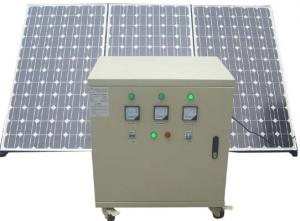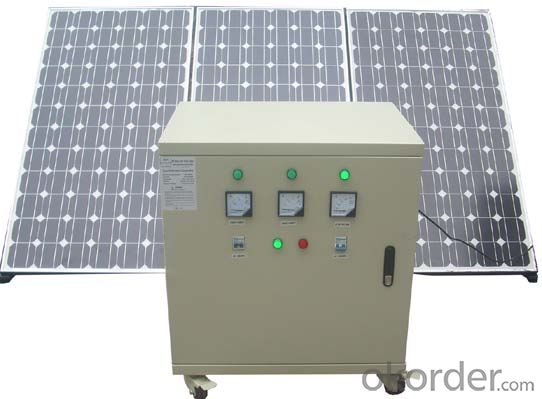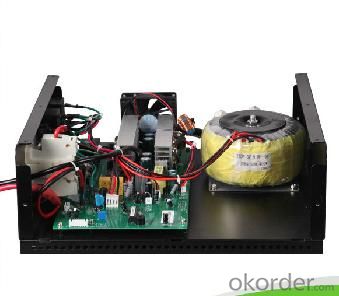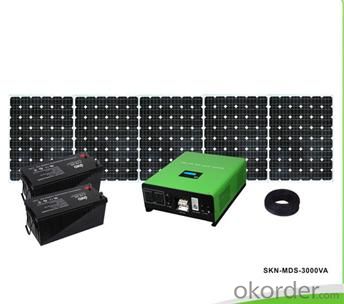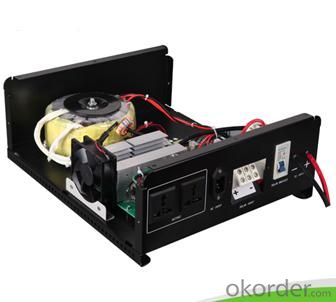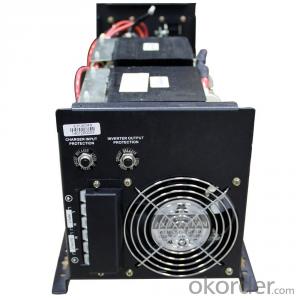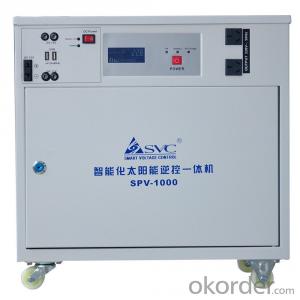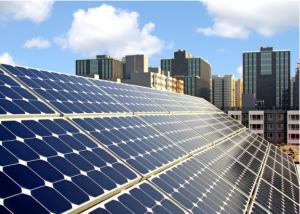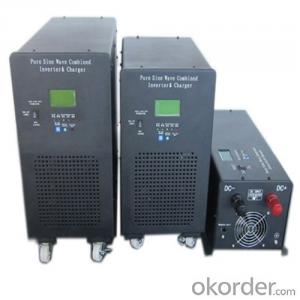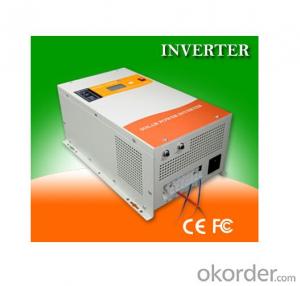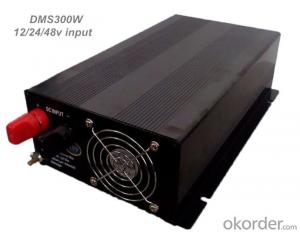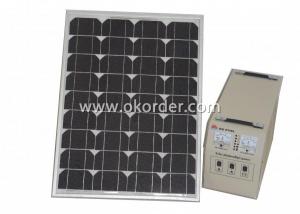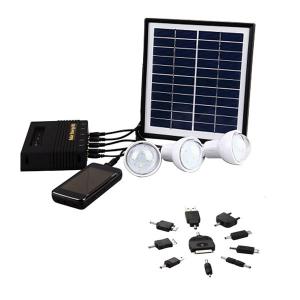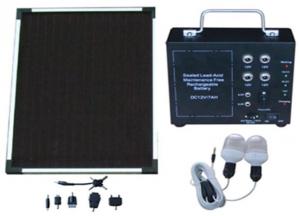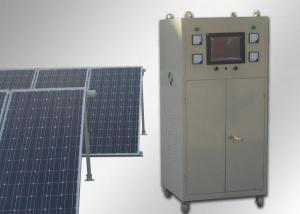Solar Energy Systems Keswick Pure Sine Wave Solar System SKN-MDS 1000VA-3000VA
- Loading Port:
- Shanghai
- Payment Terms:
- TT or LC
- Min Order Qty:
- 300 watt
- Supply Capability:
- 200000 watt/month
OKorder Service Pledge
OKorder Financial Service
You Might Also Like
Quick Details
| Specification: | Normal | Application: | Home | Output Voltage (V): | 110V or 220V |
| Load Power (W): | 800W-2400W | Solar Power (W): | 100W-3000W | Work Time (h): | as long as it works |
| Solar Panel: | Polycrystalline | Battery: | With Battry Together | form wave: | pure sine wave |
| transfer time: | less than 10ms | Inverter: | DC to AC | Solar Inverter: | Inverter With Controller Inside |
| DC: | 12V-48V | model: | from 1KVA-3KVA | pure sine wave: | yes |
| Packaging & Delivery | |
| Packaging Detail: | carton |
| Delivery Detail: | 1*20FT container within one month |
| Specifications | |
| inverter,controller building in one case | |
| pure sine wave inverter | |
| AC charger optional | |
| LED or LCD display | |
| 110V or 220V | |
Specifications
Pure Sine Wave Solar Inverter
>Solar Charge Controller Inside
>AC Charger Inside
>LED LCD Display
>Wall Mount Design CE ISO
Features:
1.Environmental protection
2.Energy-saving products
3.Portable
4.easily use
Advantages:
1.Safety and easy installation,Plug and play systems;
2.Good quality panel to ensure the high efficiency and long life needs;
3.Solar Automatic lighting controller :with adjustable run times, over-current protection;
4.Solar Batteries: Maintenance free, long life batteries
5.Lighting Source: LED lamp /Lantern (Fixed/Movable)
7.Flexible designs per client requests;
Using of scope:
It is very good for indoor use where there is shortage of electricity and for outdoor activities such as picnicking, fishing and camping. It is an ideal tool for Motor Mechanics, Farm House and small shop owners such as Hairdressers, Barbers, Cobblers, Tailors and Kiosk keepers.
Pure Sine Wave Solar Inverter SKN-MDS 1000VA To 3000VA For Home
1.Power Range: 1000VA 2000VA,3000VA
2.Power Factor: 0.8
3.DC Voltage: 12V,24V,48V
4.Include AC Charger Function Inside
5.The SKN-MDS Inverter Include Solar Charge Controller Inside
6.Pure Sine Wave Inverter SKN-MDS With AVR Function
7.Inverter With AC Charger With Solar Charge Controller With AVR All In One
8.22 Year Brand Quality Garantee
9.High End Inverter Design With Wall Mount Design
10.Popular Design With LED LCD Display
Pure Sine Wave Solar Inverter SKN-MDS Main Function Features
> Micro Processor Control
> Pure Sine Wave
> With AC Charger
> Intelligent Automatic Voltage Regulating Technology
> Intelligent Automatic Voltage Charging Technology
> Over Load, Short Circuit Protection
> Over Temperature Protection
> By Pass System
> Automatic Charge Even Inverter Is Off
> Shut Off Output By Manual If No Need Power
> Low Battery Protection
> Over Voltage, Low Voltage Protection
> With Polarity Protection
> Compatibility With Generators
> The LED&LCD Display Design Option
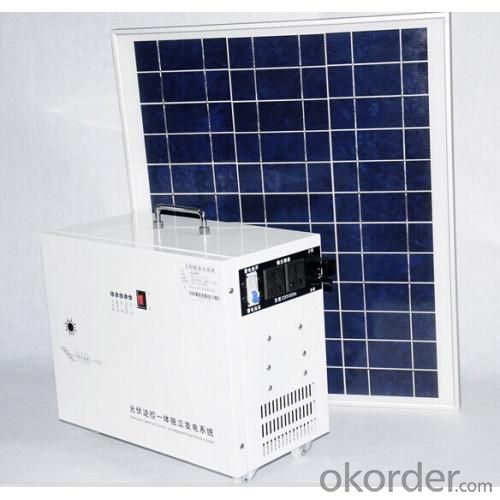
| SKN-MDS 800W SERIES TECHNICAL PARAMETER | |||
| SKN-MDS-3000-800W | |||
| Name Of Parts | Specifications | Parameters | Quantity (PCS) |
| Mono-Crystalline Solar Panels | The Maximum Power Of Solar Panels (W) | 200W | 4PCS |
| The Short Circuit Current Of Solar Panels (A) | 8.24A | ||
| The Maximum Power Current Of Solar Panels (A) | 7.51A | ||
| The Open Circuit Voltage Of Solar Panels (VDC) | 32.73VDC | ||
| The Maxium Power Voltage Of Solar Panels (VDC) | 36VDC | ||
| Battery | Maintenance Free Lead-Acid Battery | 12V/150AH | 4PCS |
| Solar Charge Controller | Rated Voltage (VDC) | 48VDC | 1PCS |
| Discharge Current (A) | 60A | ||
| Charge And Recover Voltage (VDC) | 53.2V/Lead-Acid | ||
| The Battery'S Overvoltage Protection And Recovery | 57.6V/52.8VDC | ||
| The Set Range Of Voltage When Low Voltage Off | 43.2V-46.4VDC | ||
| The Set Range Of Voltage When Low Voltage On | 48.4V-52.8VDC | ||
| Inverter | Rated Output Power (W) | 2400W | 1PCS |
| Rated Output Voltage (VAC) | 220VAC±10%, 50Hz±2Hz | ||
| Output Waveform | Pure Sine Wave | ||
| Rated Input Voltage (VDC) | 48VDC | ||
| Undervoltage Alarm (VDC) | 42±0.5VDC | ||
| Low Voltage Off (VDC) | ≤ 40.0VDC | ||
| Overvoltage Off (VDC) | ≥ 56.8VDC | ||
| Efficicency | ≥ 90% | ||
| Output | AC 220V Terminal | 220V / 10A | 1PCS |
| AC 220V Socket | 220V / 1A | 2PCS | |
| Accessories | Solar Panel Wire | 10M | 1PCS |
| Utility Power Charge Wire | 1.5M | 1PCS | |
| Portable Box Dimension (mm) | Box:470*424*244 mm, Package: 550*504*330 mm | ||
| Solar Panel Dimension (mm) | 1482*992*40 mm *4PCS | ||
| Battery Dimension (mm) | 485*172*240mm *4PCS | ||
| Weight (KG) | Box G.W.: 30Kg, Solar Panel: 17Kg*4PCS Battery: 44.5Kg*4PCS | ||
| DISCHARGE TIME (HOURS) | |||
| Item | Specifications | Quantity (PCS) | Lighting Time (Hours) |
| LED Lights | 3W | 1 | 1120 |
| Electric Fan | DC 12V/30W | 1 | 112 |
| TV | AC220V (LCD 32Inch 60W) | 1 | 56 |
| Fridge | AC220V 120W | 1 | 28 |
| Computer | AC220V 200W | 1 | 17 |
- Q: Do solar energy systems require regular inspections?
- Regular inspections are required for solar energy systems. These inspections are crucial to ensure optimal functioning and to detect any potential issues or maintenance requirements. They typically involve examining the condition of solar panels, evaluating the inverter's performance, inspecting electrical connections, and assessing overall system efficiency. By conducting regular inspections, problems can be detected early on, allowing for timely repairs or maintenance to prevent further damage or performance decline. Moreover, inspections may be necessary to comply with local regulations and maintain eligibility for incentives or warranties. Therefore, it is highly recommended to arrange regular inspections conducted by qualified professionals to guarantee the durability and effectiveness of solar energy systems.
- Q: How does a PV system convert sunlight into electricity?
- A PV (photovoltaic) system converts sunlight into electricity through the use of solar panels. These panels contain photovoltaic cells made of semiconducting materials, such as silicon. When sunlight hits these cells, it excites the electrons, causing them to flow and create an electric current. This direct current (DC) is then converted into alternating current (AC) using an inverter, which can be used to power homes, businesses, or other electrical devices.
- Q: What is the difference between a grid-tied and off-grid solar energy system?
- A grid-tied solar energy system is connected to the local electricity grid, whereas an off-grid solar energy system operates independently and is not connected to the grid. In a grid-tied system, solar panels are used to generate electricity from the sun, which is then converted into usable AC power through an inverter. This electricity is first consumed by the household or business where the system is installed. If the solar panels generate more electricity than is being consumed, the excess power is fed back into the grid, often resulting in a credit or payment from the utility company. During times when the solar panels are not generating enough power, electricity is drawn from the grid. This ensures a continuous and reliable power supply, with the grid acting as a backup. On the other hand, an off-grid solar energy system is designed to operate independently from the grid. It typically includes a battery bank to store excess electricity generated by the solar panels, which can then be used during times when the panels are not producing enough power. Off-grid systems also require an inverter to convert the DC power from the solar panels into usable AC power. These systems are commonly used in remote locations where connecting to the grid is costly or not feasible. The main difference between the two systems lies in their level of independence and connection to the grid. Grid-tied systems offer the advantage of being able to sell excess electricity back to the utility company, allowing for potential cost savings or even revenue generation. They also provide a reliable power supply, as grid power can be used when solar production is low. On the other hand, off-grid systems provide complete energy independence and are not reliant on the grid. However, they require careful planning and sizing to ensure sufficient power is available at all times, as there is no backup from the grid. Additionally, off-grid systems often require more complex equipment, such as batteries, to store and manage electricity.
- Q: Can solar energy systems be used for powering off-grid military operations?
- Yes, solar energy systems can be effectively used for powering off-grid military operations. Solar panels can generate electricity in remote locations, reducing dependency on traditional fuel sources and ensuring a reliable power supply. This sustainable and renewable energy source helps enhance operational flexibility, reduce logistical challenges, and decrease the environmental impact of military operations. Additionally, solar energy systems can be easily deployed, provide silent operation, and require minimal maintenance, making them suitable for various off-grid military applications.
- Q: How does net metering work?
- Net metering is a billing arrangement that allows solar panel owners to receive credit for the excess electricity their panels generate and feed back into the grid. It works by measuring the difference between the electricity a solar system produces and the amount it consumes from the grid. When the solar system generates more electricity than is being used, the excess energy is sent back to the grid, and the owner receives credits for it. These credits can then be used to offset the electricity consumed from the grid during periods when the solar panels are generating less power, such as at night or during cloudy days. Overall, net metering enables solar panel owners to save money by effectively "banking" their excess energy production.
- Q: What is the role of solar energy systems in promoting sustainability?
- Promoting sustainability is a crucial function of solar energy systems as they offer a clean, renewable, and abundant source of energy. Unlike fossil fuels, solar energy systems do not emit harmful greenhouse gases or contribute to climate change. Instead, they generate power without producing any pollution or emissions. This not only helps to mitigate the negative impacts of climate change but also reduces reliance on finite fossil fuel resources, which are depleting rapidly. In addition to their environmental benefits, solar energy systems also contribute to sustainability by decentralizing energy production. Unlike traditional energy sources like coal-fired power plants, solar energy systems can be installed on rooftops or in close proximity to where the energy is needed. This reduces energy losses during transmission and distribution, resulting in improved overall efficiency. Moreover, solar energy systems enable individuals and communities to become more self-sufficient and less dependent on centralized energy grids. By producing their own electricity, households and businesses can lower their energy bills and have a more stable and reliable energy supply, especially in remote areas or during power outages. This decentralization also enhances energy security and resilience, as it reduces vulnerability to disruptions caused by natural disasters, cyber-attacks, or other emergencies. Furthermore, solar energy systems have a long lifespan and require minimal maintenance, leading to lower operational costs compared to conventional power generation technologies. This makes solar power an economically viable option, particularly in the long term. As the cost of solar panels and related technologies continues to decrease, more individuals, businesses, and governments are investing in solar energy systems, further driving adoption and creating a positive feedback loop for sustainability. Beyond the environmental and economic benefits, solar energy systems also have social implications. They provide access to electricity for underserved communities or those lacking reliable energy sources. This can improve the quality of life, support economic development, and create educational opportunities, particularly in developing countries. In conclusion, solar energy systems play an integral role in promoting sustainability through their reduction of greenhouse gas emissions, improvement of energy efficiency, enhancement of energy security, and facilitation of economic development. By harnessing the power of the sun, we can create a more sustainable future for future generations.
- Q: How to calculate the income of photovoltaic system
- Hypothesis: 1 my peak electricity price of 1 yuan / degree, the flat price of $0.7 / degree, the local coal desulfurization unit benchmark price of 0.4 yuan / degree. 2 my home at noon to 1 points solar power generation of 90 degrees, power consumption of 40 degrees; in the afternoon from 5 to 6 solar power generation of 10 degrees, power consumption of 60 degrees. Results: 1 according to the total solar energy power generation and the total energy consumption calculation two times my solar power electricity is 100 degrees, 100 degrees, more than electricity difference is zero; so I save electricity 85 yuan, receive subsidies 35 yuan, the total revenue of 100kWh * [(1 + 0.7) /2 + /kWh = 0.35 yuan) 120 yuan.
- Q: Can solar energy systems be used for powering sports stadiums or arenas?
- Absolutely, sports stadiums or arenas can definitely utilize solar energy systems for power. In fact, numerous stadiums and arenas worldwide have already begun implementing solar energy as an environmentally-friendly and economically-viable power source. Solar energy systems, like solar panels, capture the sun's energy and convert it into electricity. This generated electricity can then be utilized to power various components of sports stadiums or arenas, including lighting, scoreboards, sound systems, and even electric vehicle charging stations. The quantity of solar energy required to power a stadium depends on its size, energy requirements, and the level of energy efficiency implemented. There are multiple advantages to employing solar energy in sports stadiums or arenas. Firstly, it is a clean and renewable energy source, contributing to a reduction in greenhouse gas emissions and a decrease in reliance on fossil fuels. This aligns with the increasing global focus on sustainability and combatting climate change. Secondly, solar energy offers long-term cost savings. Although the initial installation costs may be higher compared to traditional energy sources, the operational and maintenance expenses of solar panels are relatively low. Over time, the energy generated by solar panels can offset electricity costs, resulting in significant savings in the long run. Furthermore, solar energy systems can also serve as a visible symbol of environmental responsibility, inspiring fans, athletes, and communities to adopt sustainable practices. Sports stadiums and arenas often attract large audiences and media attention, making them high-profile venues. By embracing solar energy, these facilities can demonstrate their commitment to clean energy and motivate others to do the same. In conclusion, solar energy systems can effectively power sports stadiums or arenas. They provide a clean, renewable, and cost-effective alternative to traditional energy sources, while also promoting sustainability and inspiring others to embrace clean energy solutions.
- Q: What are the different financing options for solar energy systems?
- There are several financing options available for solar energy systems, including purchasing the system outright with cash, taking out a solar loan, leasing the system, or entering into a power purchase agreement (PPA). Each option has its own advantages and considerations, such as upfront costs, ownership of the system, maintenance responsibilities, and potential savings. It is important to research and compare these options to determine which one aligns best with your financial goals and circumstances.
- Q: How do solar energy systems impact the overall sustainability of a home?
- Solar energy systems have a significant positive impact on the overall sustainability of a home. By harnessing the power of the sun, these systems generate clean and renewable energy, reducing reliance on fossil fuels and decreasing greenhouse gas emissions. Solar panels promote energy efficiency, helping to lower electricity bills and save money in the long run. Additionally, solar energy systems contribute to the resilience of a home, enabling homeowners to be less dependent on the grid during power outages. Overall, solar energy systems play a vital role in enhancing the sustainability and environmental footprint of a home.
Send your message to us
Solar Energy Systems Keswick Pure Sine Wave Solar System SKN-MDS 1000VA-3000VA
- Loading Port:
- Shanghai
- Payment Terms:
- TT or LC
- Min Order Qty:
- 300 watt
- Supply Capability:
- 200000 watt/month
OKorder Service Pledge
OKorder Financial Service
Similar products
Hot products
Hot Searches
Related keywords
